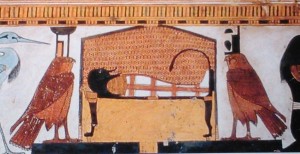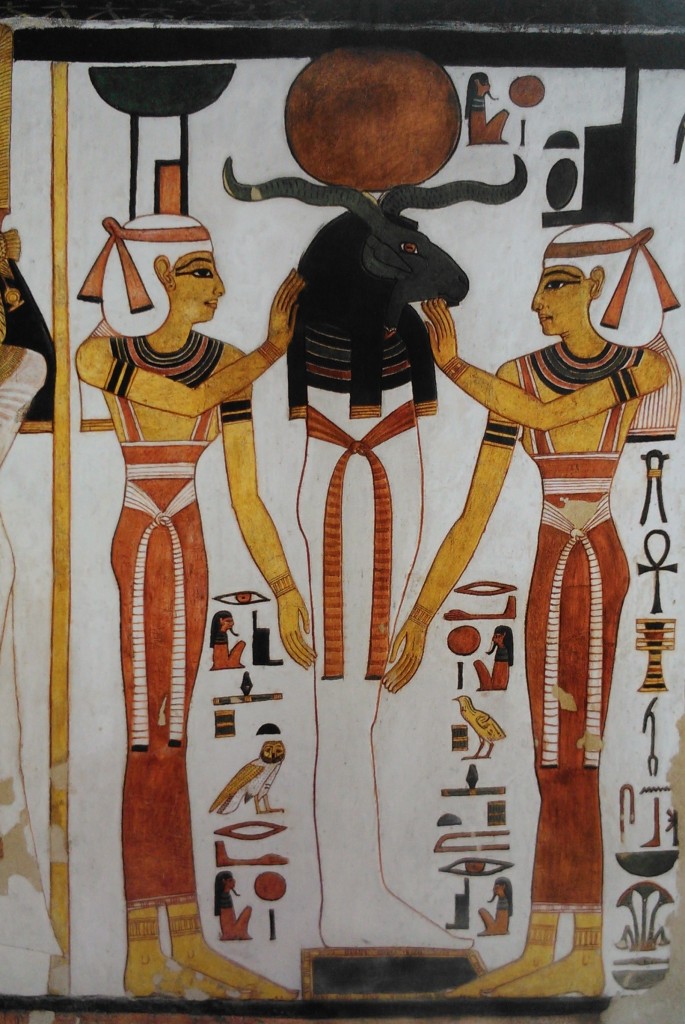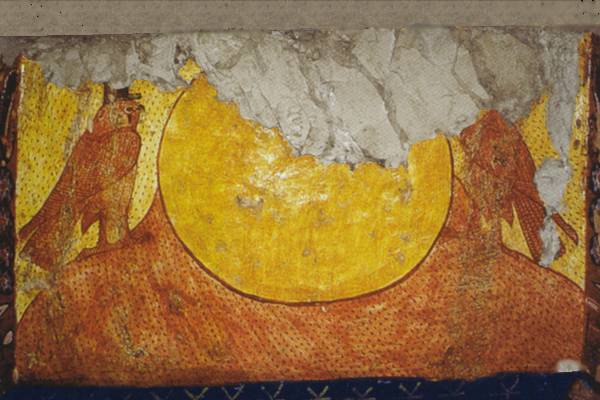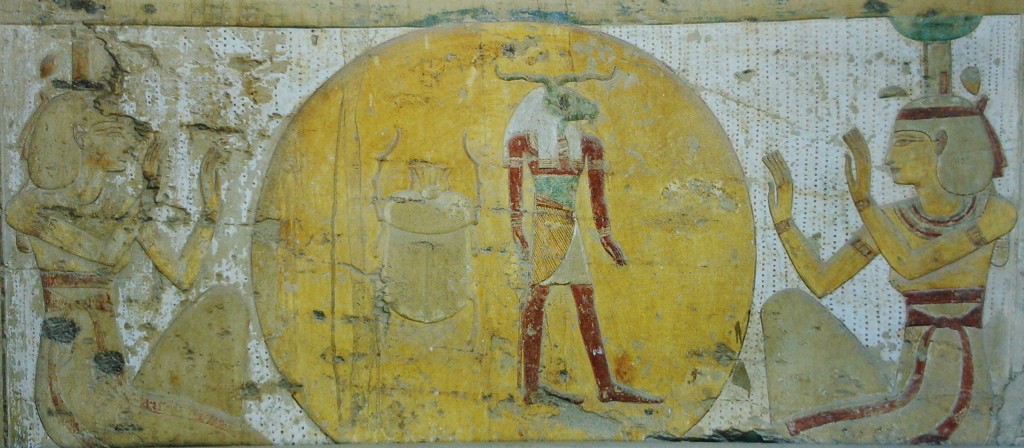It was a fact, that the ancient Egyptian corpus of images needed an iconography for expressing the union of Re and Osiris. And little by little in this iconography Isis and Nephthys, the two mourners of Osiris, became essential.
In the XIX Dynasty the ancient Egyptian artists conceived some of the most famous images of this conception combining same as ever iconography.

Isis and Nephthys flanking the corpse. Tomb of Nefertari. XIX Dynasty
For instance in the tomb of Nefertari, wife of Ramses II, the chapter 17 of the Book of the Dead was illustrated with the typical image of the corpse with the two mourners Isis and Nephtys, not as women, but as kites.
In this same tomb it was included the Litany of Re; it was an ancient Egyptian religious text, which was inscribed in all Ramesside tombs. It described different forms of the sun god and it stressed specially the symbolic union of Re and Osiris and the identification of the dead king with this dual god.

Isis and Nephtys with Re-Osiris. Litany of Re from the tomb of Nefertari. XIX Dynasty.
In this context the ancient Egyptian artist adapted the typical scene mentioned above and represented Isis and Nephthys adoring the image of Re-Osiris, as a hybrid figure with three main features: the body of a mummy evoking Osiris and the ram head with a solar disk recalling Re. The corpse of Re-Osiris could not skip the figures of Isis and Nephthys. As the professional mourners of the mummy, the total resurrection of this god, even being solar and Osirian, depended on them.
But the importance of Isis and Nephthys was so big, that already from the XIX Dynasty they were even included in a pure solar iconography. So, in the lower part of the lintel at the entrance to the tomb of Nefertari the two kites (Isis and Nephthys) were depicted flanking the solar disk.

Isis and Nephthys as kites flanking the solar disk. Ceiling of the entrance tomb of Nefertari. Photo: www.osirisnet.net
Under the reign of Sethos I the opening scene of the Litany of Re was for the first time the image of the scarab and the ram-headed god inside the solar disk, which was the depiction of the sun god: young (scarab), plenitude (disk) and maturity (ram-headed god).
At the entrance of the tomb of Merneptah and Siptah the ancient Egyptian artist conceived a new combination of the solar and the Osirian conceptions: the solar disk with the scarab and the ram-headed god flanked by the two goddesses Isis and Nephthys.

Isis and Nephtys at both side of the sun. Tomb of Merneptah. XIX Dynasty. Photo: The Theban Mapping Project.
So, Isis and Nephthys were crucial for the concept of resurrection. In origin this idea belonged to the Myth of Osiris, but later on it was also transferred to the solar religion. The result was a new iconography from the XIX Dynasty, which became even richer in the XX Dynasty, as we will see in the following post.
This is most informative and interesting. I always believed that not enough emphasis was placed on the Heliopolitan solar roles of Isis and Nephthys in particular. Their longterm fame was made, of course, by the association with the Osiris “movement” starting in the Fifth and Sixth Dynasties, but I think both of them might have had solar roles to begin-with. I do think Nephthys was a goddess who started out as the companion of Seth, when these various deities were brought together to form the Heliopolitan “family” of gods. I think maybe she and Isis were newly created Heliopolitan “forms” of other, older goddesses. Altenmuller stipulates that Nephthys was really a Heliopolitan form of Seshat, who had been one of Seth’s old companion-goddesses in the First Dynasty. Nb.t-hw.t would be just a descriptive: “Temple/Tomb/Embalming Chamber Lady.” Altenmuller thinks Isis was actually a priestess of Hathor, but I always found that to be kind of fanciful. Seems to me that she was an extraction from the actual hieroglyphic name of Osiris, signifying the royal throne that belongs to Osiris and Horus (both being identified with Re, of course). It’s so amazing to wonder what traditions and circumstances, historically, led the theologians of Heliopolis to solidify these religious ideas as we see them in the Pyramid Texts. But we know, for sure, that Seth and Horus existed long before and quite apart from the Heliopolitan religion. Both gods must have had female companions of some degree: Isis may have been a Heliopolitan “version” of Hathor, as mother of Horus, etc. Nephthys may have been a form of Hathor, too … Hathor in her different solar manifestations: Day Boat, Evening Boat, etc. It’s fun to ponder the possibilities and look for clues! I do indeed enjoy your insight and your page.